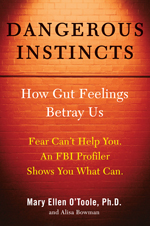We all like to think of ourselves as smarter and less naïve than the typical crime victim. We like to think that we somehow possess instincts—a Danger Instinct—that would alert us when a dangerous person is in our midst. For instance, we tend to trust our bodily sensations: hair pricking on the backs of our necks, shivers down our spines, racing heartbeats and sinking gut feelings. We’ve been taught to read such sensations as signs of trouble, and the absence of them as signs of safety.
In interviewing crime victims during my career as an FBI profiler, I can tell you something with conviction: We don’t have a reliable and consistent danger instinct. Fear does not keep you safe. Gut feelings don’t either. Neither does luck.
I would like to teach you a process that does. Based on what I learned as an FBI profiler, it’s my goal to teach you how to understand human behavior so you can use that information to make better decisions, size up people more accurately, assess for threatening situations, minimize threats in your everyday life, and conduct better “interviews” with people in everyday life situations—both at work and at home.
Dangerous Instincts teaches you how fear and gut feelings often fail to protect you from physical, financial, legal, and professional harm. Instead of relying on gut feelings, you’ll learn to use the SMART method, which I developed and used in the FBI, for making everyday decisions such as how to decide:
- Which neighbor will best protect the spare key to your home
- The best way to confront the parent of a bully
- The safest method for responding to a threat from another person
- How to hire a reliable and trustworthy housekeeper, babysitter or contractor
With straightforward advice that’s easy to implement, Dangerous Instincts teaches you the tools I used as a profiler to evaluate a stranger’s character, weigh the risks of a situation, and use a way of analysis to stay safe.
